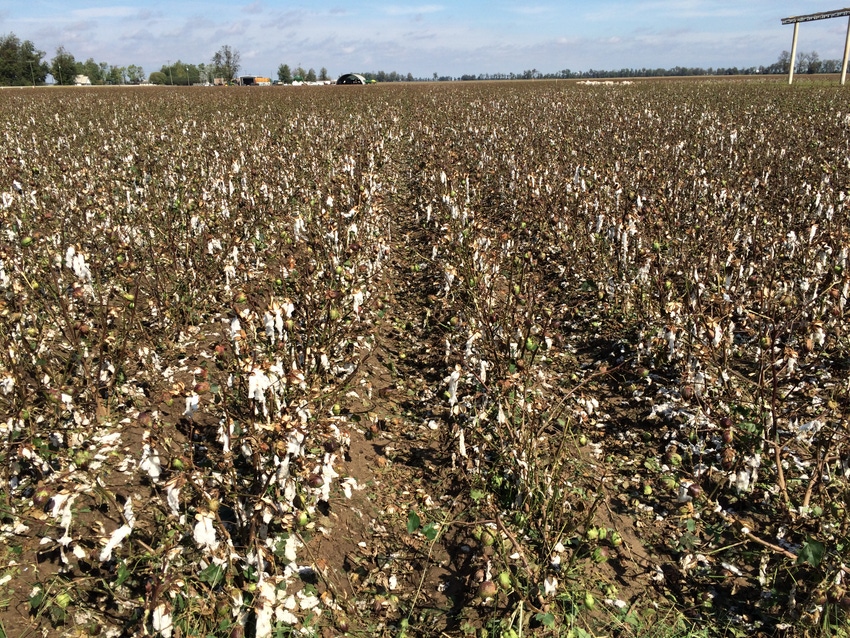
Early-morning storms that swept through north central Arkansas damaged an estimated 40,000 cotton acres in Craighead and Mississippi county. The Oct. 7 hailstorm was especially cruel as producers were just about to set pickers loose.
“It’s terrible that this happened,” says Eric Grant, Craighead County Extension agent. “It just feels wrong, you know? The producers were ready to roll into those fields with 2.5- to 3-bale cotton. All the applications had occurred, all the money had been spent, all the sweat had rolled. The fields had been defoliated. The farmers had their cotton yanked out of their hands.”
Grant had walked some of the now-ruined fields a week ago. “At that time, the cotton was really pretty, fluffed up.
“It’s not pretty now. Many of the fields look like they’ve actually been picked. Some of the hail was golf ball-sized so it’s easy to see why it took that much off the plants. Other fields have cotton strung out and it looks like it needs a scrapping pick. There are whole bolls on the ground, smashed bolls, bolls bruised by the hail.”
Of the 40,000 damaged acres, the area FSA office believes 10,000 to 15,000 acres won’t even have a picker run through it. The other 25,000 acres will have considerably less yield and, of course, grades on that cotton are expected to be very poor. For those fields, there are questions about whether it will be financially beneficial to harvest.
And the storms blow won’t be absorbed by producers alone. The gins and infrastructure around them will undoubtedly be harmed. Potentially some 30,000-plus bales of cotton won’t ever make it to gins that were expecting a bumper crop.
Several waves
The storm rolled through the area in several waves. “One hit around 1:30 to 2:00 a.m.,” says Bill Robertson, Arkansas Extension cotton specialist. “A second one -- the one that hit Black Oak about 6 a.m. -- did the most damage.”
The situation is proving worse than Robertson originally thought. “At first, between the two counties, we estimated around 10,000 acres were ‘impacted’ and some 7,000 acres -- with 50 percent, or more, of the lint lying on the ground -- were ‘severely impacted.’
“After that, though, some producers that thought they had minimal damage went back to their fields for a closer look. They’re now saying, ‘I’ve got green bolls all over the ground.’”
Robertson has no qualms about the 40,000-acre damage estimate. “There’s lint on the ground all over -- and that may have come from wind and rain, not hail. If it’s on the ground, it won’t be picked. Think about it: one good boll on the ground per foot or row means a loss of 30 or 40 pounds of lint.
“It’s a bit deceiving driving the roads looking at some of these fields. You think, ‘It doesn’t look that bad.’ Then, you get out and walk into the field and realize a quarter to a third of the lint is on the ground.”
The gin at Black Oak believed area cotton would average right at three bales. “Well, if a third of that is on the ground, that’s a bale lost to the storm.”
And up to four inches of rain is predicted in the next few days. “That’s just adding to misery. Even in fields where there’s only a quarter of the cotton on the ground won’t fare well in that kind of storm. The cotton is already strung out and it won’t take much to make it drop.”
Robertson has received reports from some producers who have gone into damaged fields with a picker. “They’re averaging about 140 pounds of lint. That’s about 10 percent of what was on those plants to start.”
Additional worries
It isn’t just cotton that was affected by the storm.
“Some of the fields that were cutting 80-bushel soybeans are now in the teens,” says Robertson. “Hail and wind took out the pods.”
There are additional worries for the bolls that managed to stay attached to the plants. “There are a lot of green bolls still on the stems,” says Robertson. “They’re badly bruised, though. The way the stems appear looks like a picker has already run through.
“Back in the old days when there were a lot of green bolls that wouldn’t open you might run a picker through. That would often work like putting out another shot of boll opener. Lots of folks called that ‘prepping with a picker.’
‘Having scars on the stalks doesn’t concern me that much. That won’t keep the bolls from opening. What does concern me is the damaged tissue on the green bolls. They are really banged up and I don’t know how well they’ll open. I don’t have a lot of confidence they’ll give us much.”
The damage is mostly in eastern Craighead County. “We’ve not had any reports of damage west of (Crowley’s Ridge),” says Grant. “It’s early on but there’s at least a few thousand acres affected. The manager of the gin at Black Oak estimates that of the 12,000 acres they service only a thousand is worth harvesting.”
There is damage north to Monette and south to Caraway. “The farther east you travel, the worse it is,” says Grant. “There is some crop damage west of the St. Francis River around Dixie -- we think the hail probably started around there.”
What federal help is currently available for impacted producers? With 72 percent of Craighead County’s cotton acreage reportedly damaged it is fairly certain a disaster will be declared. Once that occurs, affected farmers will be eligible for low-interest loans.
About the Author(s)
You May Also Like




